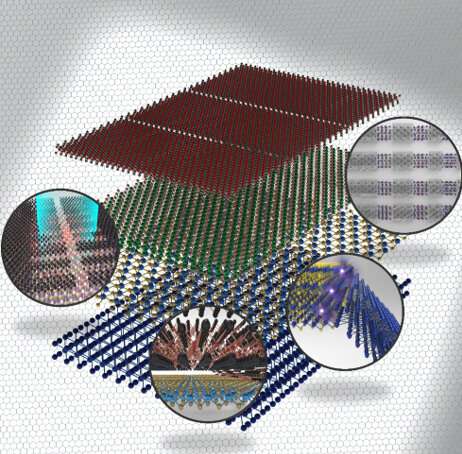Comprehensive review of heterogeneously integrated 2-D materials

In a paper published in Nano, a group of researchers from Sungkyunkwan University, South Korea provide a comprehensive review of heterogeneously integrated two dimensional (2-D) materials from an extensive library of atomic 2-D materials with selectable material properties to open up fascinating possibilities for the design of functional novel devices.
Since the discovery of graphene by Andre Geim and Konstantin Novoselov, 2-D materials, e.g., graphene, black phosphorous (BP), transition metal dichalcogenides (TMDCs), and hexagonal boron nitride (h-BN) have attracted extensive attention due to their broad physical properties and wide range of applications to electronic and optoelectronic devices. Research on these 2-D materials has matured to the point where an extensive library of atomically thin 2-D materials with selectable material properties has been created and continues to grow.
By combining or stacking these 2-D materials, it is possible to construct 2-D heterostructures, which are built by directly stacking individual monolayers comprising different materials. Each monolayer within a 2-D heterostructure is highly stable, due to strong covalent bonds between the atoms within that monolayer. However, the forces between the monolayers that keep said monolayers stacked one above the other to form the 2-D heterostructure happen to be relatively weak van der Waals interactions. Due to this, each of the monolayers retains its intrinsic properties.
Moreover, unlike in conventional semiconductor heterostructures where component material selection is restricted to those with similar lattice structures, the lattice mismatch requirements of stacked heterostructures can be relaxed due to the weakness of the van der Waal's forces. This means that one can combine insulating, semiconducting, or metallic 2-D materials to form a single 2-D heterostructure despite their different lattice structures.
When a monolayer is stacked in combination with other monolayers made out of different materials, a variety of new heterostructures with atomically thin 2-D heterojunctions can be created. Heterostructures made from a particular combination of materials will have a certain set of physical characteristics depending on which materials they are made from. The unusual physical characteristics of 2-D heterostructures make them suitable for use in a wide range of applications.
In this review, various 2-D heterostructures are discussed along with an explanation of novel electronic and optoelectronic properties, advanced synthesis technical developments, as well as new functional applications available. It provides an understanding of the current research trends in 2-D materials, so as to explore future possibilities for nanomaterial research.
More information: Indhana Veera Sankar et al, Heterogeneous Integration of 2D Materials: Recent Advances in Fabrication and Functional Device Applications, Nano (2019). DOI: 10.1142/S1793292019300093
Provided by World Scientific Publishing




















